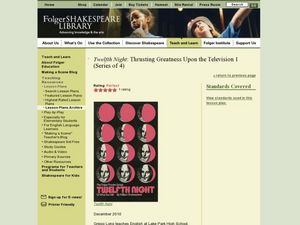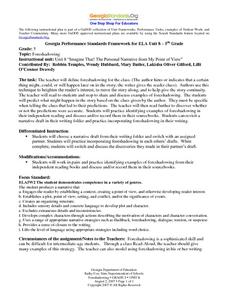Curated OER
Performances of Lear's Speeches
High schoolers engage in a lesson plan which gives them an introduction to the text, as a way to compare and contrast the lesson plan learned at the end of the play. They utilize worksheets imbedded in this plan to interpret what Lear is...
Curated OER
Double, Double, Toil and Trouble: A Dual Exploration of Macbeth
Students emulate a key practice of Renaissance theater: doubling. The goal of this lesson is for students to experience-to see, hear, and feel-the differences between characters. Each group presents scenes to the rest of the class.
Curated OER
MTV Othello
Students read a scene in Othello. They create a performance of a song in Othello. They perform their "ow Song"s and compare and contrast the interpretations.
Curated OER
Status Games
Tenth graders, in groups, participate in a simulation activity in which they are assigned a certain "status" role to play in a given situation. After the simulation, they reveal their status roles and discuss what they observed. They...
Curated OER
Introduction to "As You Like It"
Students explore the character relationships and their connection in the play "As You Like It." Working in groups, students act out the various scenes from the play and discuss the characters and their actions in the scene. Students...
Curated OER
Do the Research! Macbeth Becomes King of Scotland
In this research worksheet, learners find information about Macbeth the King of Scotland. Students answer 4 essay and short answer questions about Macbeth.
Curated OER
Words, words, words
Young scholars discuss words that represent the big ideas in Othello and that recur throughout the play. They are assigned words to track throughout the text, recording which character says the word and in what context.
Curated OER
Twelfth Night: Thrusting Greatness Upon the Television 1
Students create skits based on pairs of words. In this Twelfth Night lesson, students create a cluster map in which they brainstorm a dialogue/scene based on their word pair. Students perform and record their scenes and discuss...
Curated OER
Romeo and Juliet Family Shields
Students create a family shield for themselves as part of the Montague or Capulet family. In this Romeo and Juliet lesson, students divide into the two warring clans. Students each create a shield representing themselves as...
Curated OER
Introducing the Ghost: Asking Questions and Finding Answers
Students write words that describe the Ghost in Hamlet and act out scenes to grab the audience's attention. In this Hamlet lesson plan, students use language to interpret feeling and grab the audience's attention.
Curated OER
Romeo and Juliet
Young scholars read Romeo and Juliet and then write an essay from the point of either Lord Capulet or Friar Lawrence persuading someone to adopt their views concerning marriage.
Curated OER
OF PASSIONS SUNDRY AND STRANGE
Students examine on-line primary sources to gain an understanding of Elizabethan attitudes toward different character traits. They use these ideas to help explain Lear, or another strong character, more fully.
Curated OER
Reader's Theater, King Lear, and the Language of Gesture
Students perform a Reader's Theater of a small section of the play, King Lear. They examine the text, read a handout for Reader's Theater techniques, cut and reorder lines in small groups, and add choreography to perform their scene.
Curated OER
And. . . Freeze!
Learners read a short section of a scene very closely and develop a tableaux as a start to the performance process. They write a paragraph in the voice of a character. They present their beginning, middle and end tableaux to the class.
Curated OER
"Thou hast set me on the rack": A Dramatic Reading of Iago's Most Poisonous Lines
Students select and analyze quotations from Othello, and do a dramatic reading to illustrate the power of Iago's most poisonous words.
Curated OER
Enter Players: Constructing Character Connections in Hamlet
Students research the characters of Hamlet. In this Shakespearean literature lesson plan, students complete a pre-reading activity designed to improve their familiarity with the characters in the story. In small groups,...
Curated OER
The Bullying of Malvolio
Learners explore Malvolio's behavior and treatment in Twelfth Night. In this literature lesson, students examine the characteristics of a bully. They then work in groups and analyze scenes to determine whether Malvolio fits...
Curated OER
Remembrance of Yours--Analyzing Characters Using Mementos
Students choose two characters in Hamlet and symbolize the characters with an object, or find an object that the characters might carry. For this Hamlet lesson, students find an object to represent each character they choose. The object...
Curated OER
Thrusting Greatness Upon the Television 2
Students create mini-scenes using two random lines from Orsino's speech. For this Twelfth Night lesson, students are given random lines from Orsino's speech and create a skit using their given lines at the beginning and the...
Curated OER
Appreciating the Language and Interpreting the Meaning of Hamlet's Soliloquy
Young scholars analyze Hamlet's soliloquy, "To be or not to be." In this Hamlet lesson, students define unfamiliar words in the soliloquy and interpret the lines. Young scholars then read the lines aloud and identify...
Curated OER
Investigating Othello: Peeling Away Layers of Meaning
Students analyze piece of literature by looking at it from one perspective and then by re-evaluating what they have discovered when other layers of meaning are added.
Curated OER
O Time, thou must untangle this": Tangling up the Love in Twelfth Night
Tenth graders are broken into groups to review a section of The Twelfth Night. They are then given a handout of the same material in which they are to break up material which conveys a single idea. They are to preform this idea to the...
Curated OER
Trust
Pupils read and discuss Romeo and Juliet Act IV, Scenes 1 and 2. They compare the unfolding action with yesterday's predictions. They consider the concepts of trust, fate, and self-determination.
Curated OER
Foreshadowing
Students read and discuss Act V, Scene 1. They define foreshadowing and identify examples of it from the text. They edit a partner's diary entry. They identify key ideas from the scene.
Other popular searches
- Life of William Shakespeare
- William Shakespeare Quotes
- Who Was William Shakespeare
- Poetry William Shakespeare
- William Shakespeare Bio
- William Shakespeare Biography

























